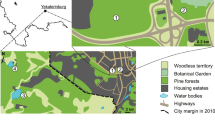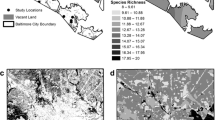Abstract
We conducted two studies on how highways affect their adjacent habitats by sampling carabid beetles (Coleoptera, Carabidae) in patches of formerly continuous forest next to highways. (1) We sampled carabids at 14 highway intersections near Helsinki, Finland. Each intersection (constructed 2–40 years ago) had two forested patches to study: a remnant (0.5–37.4 ha) and, isolated from the remnant by an intersection lane, an islet (size 0.2–1.8 ha). Pitfall trap catch data (2301 carabids, 25 species) showed that remnants hosted higher catches of three carabid species, and slightly higher species richness, than islets (patch-size effect). Time since intersection construction had no apparent effect on carabids. Traffic volume along the intersection lane determined the assemblage structure of carabids in dry patches, and the abundance of a forest carabid Calathus micropterus. Compared to moist patches, drier patches hosted lower catches of four generalist species; they also had different assemblages of carabids (habitat-type effect). An interaction between patch size and habitat type for a forest generalist Pterostichus oblongopunctatus indicated that the patch-size effect was dependent on habitat type. (2) We examined possible dispersal of carabids among forested patches that were separated by highway lanes in Drenthe, the Netherlands. We released 2696 marked individuals of 10 species, and recaptured 376 using dry pitfall traps. We found no evidence for inter-patch movement for nine forest species, but 22 of 225 recaptured individuals of Poecilus versicolor, an eurytopic open-habitat species, had crossed the highway. Catches of seven forest species were also significantly lower in the road verges, compared to the adjacent forests. These two studies suggest that (i) decreasing patch size negatively affects forest-carabid catch and overall species richness, (ii) habitat type can affect the intensity of the patch-size effect, (iii) carabid assemblages of forest fragments vary with traffic volume (which may be linked with urbanization), (iv) forest carabids rarely cross highways, and (v) open habitats associated with road margins are dispersal barriers for forest carabids.
Similar content being viewed by others
References
Anon 2003. Road Facts 2003. Finnish Road Administration. Available at http://www.tiehallinto.fi/.
J. Battin (2004) ArticleTitleWhen good animals love bad habitats: ecological traps and the conservation of animal populations Conservation Biology 18 1482–1491 Occurrence Handle10.1111/j.1523-1739.2004.00417.x
I. Borg P. Groenen (1997) Modern Multidimensional Scaling: Theory and Applications Springer-Verlag New York 471
L. Breiman J.H. Friedman R.A. Olshen C.G. Stone (1998) Classification and Regression Trees CRC Press Boca Raton, Florida.
G. De’ath (2002) ArticleTitleMultivariate regression trees: a new technique for modeling species–environment relationships Ecology 83 1105–1117
P.J. Den Boer (1977) ArticleTitleDispersal power and survival. Carabids in a cultivated countryside Miscellaneous Papers Landbouwhogeschool Wageningen 14 1–190
P.J. Den Boer (1990) ArticleTitleDensity limits and survival of local populations in 64 carabid species with different powers of dispersal Journal of Evolutionary Biology 3 19–48 Occurrence Handle10.1046/j.1420-9101.1990.3010019.x
De Vries H.H. 1996. Viability of Ground Beetle Populations in Fragmented Heathlands. Ph.D. thesis, University if Wageningen.
B.G. Dickson P. Beier (2002) ArticleTitleHome-range and habitat selection by adult cougars in Southern California Journal of Wildlife Management 66 1235–1245
Dufrêne M. 1998. Program IndVal. Version 2.0. – Available at http://mrw.wallonie.be/dgme/sibw/outils/indval/home.html.
M. Dufrêne P. Legendre (1997) ArticleTitleSpecies assemblages and␣indicator species definition: the need of an asymmetrical and flexible approach Ecological Monographs 67 345–366
S.J. Dyer J.P. Oȁ9Neill S.M. Wasel S. Boutin (2002) ArticleTitleQuantifying barrier effects of roads and seismic lines on movements of female woodland caribou in northeastern Alberta Canadian Journal of Zoology 80 839–845 Occurrence Handle10.1139/z02-060
A.-K. Eisto M. Kuitunen A. Lammi V. Saari J. Suhonen S. Syrjäsuo P.M. Tikka (2000) ArticleTitlePopulation persistence and offspring fitness in the rare bellflower Campanula cervicaria in relation to population size and habitat quality Conservation Biology 14 1413–1421 Occurrence Handle10.1046/j.1523-1739.2000.99283.x
B.C. Eversham M.C. Telfer (1994) ArticleTitleConservation value of roadside verges for stenotopic heathland Carabidae: corridors or refugia? Biodiversity and Conservation 3 538–545 Occurrence Handle10.1007/BF00115159
R.T.T. Forman (2000) ArticleTitleEstimate of the area affected ecologically by the road system in the United States Conservation Biology 14 31–35 Occurrence Handle10.1046/j.1523-1739.2000.99299.x
R.T.T. Forman L.E. Alexander (1998) ArticleTitleRoads and their major ecological effects Annual Review of Ecology and Systematics 29 207–231 Occurrence Handle10.1146/annurev.ecolsys.29.1.207
R.T.T. Forman D. Sperling J.A. Bissonette A.P. Clevenger C.D. Cutshall V.H. Dale L. Fahrig R. France C.R. Goldman K. Heanue J.A. Jones F.J. Swanson T. Turrentine T.C. Winter (2003) Road Ecology. Science and Solutions Island Press Washington-Covelo-London
C.C. Gloyne A.P. Clevenger (2001) ArticleTitleCougar Puma concolor use of wildlife crossing structures on the Trans-Canada highway in Banff National Park, Alberta Wildlife Biology 7 117–124
E. Halme J. Niemelä (1993) ArticleTitleCarabid beetles in fragments of coniferous forest Annales Zoologici Fennici 30 17–30
I. Hanski (1999) Metapopulation Ecology Oxford University Press Oxford
M. Hourdequin (2000) ArticleTitleSpecial section: ecological effects of roads Conservation Biology 14 16–17 Occurrence Handle10.1046/j.1523-1739.2000.99358.x
Jongman R.H.G., Ter Braak C.J.F. and Van Tongeren O.F.R. 1995. Data Analysis in Community and Landscape Ecology.Cambridge University Press.
I. Keller C.R. Largiader (2003) ArticleTitleRecent habitat fragmentation caused by major roads leads to reduction of gene flow and loss of genetic variability in ground beetles Proceedings of the Royal Society of London Series B 270 417–423 Occurrence Handle10.1098/rspb.2002.2247 Occurrence Handle12639322
Kinnunen H. 1999. In Search of Spatial Scale – Carabid Beetle Communities in Agricultural Landscapes. Ph.D. thesis, University of Helsinki.
M. Koivula (2002) ArticleTitleAlternative harvesting methods and boreal carabid beetles (ColeopteraCarabidae) Forest Ecology and Management 167 103–121 Occurrence Handle10.1016/S0378-1127(01)00717-4
M. Koivula (2003) The forest road network – a landscape element affecting the distribution of boreal carabid beetles (ColeopteraCarabidae) J. Szyszko P.J. den Boer T. Bauer (Eds) How to Protect or What We Know about Carabid Beetles University of Warsaw Press Warsaw 287–300
M. Koivula V. Hyyryläinen E. Soininen (2004) ArticleTitleCarabid beetles (ColeopteraCarabidae) at forest-farmland edges in southern Finland Journal of Insect Conservation 8 297–309 Occurrence Handle10.1007/s10841-004-0296-9
M. Koivula D.J. Kotze (2005) Carabid beetles in median strips of three highways around the city of HelsinkiFinland G. Lövei S. Toft (Eds) European Carabidology 2003. Proceedings of the 11th European Carabidologist Meeting University of Århus Århus 151–161
M. Koivula D.J. Kotze L. Hiisivuori H. Rita (2003) ArticleTitlePitfall trap efficiency: do trap sizecollecting fluid and vegetation structure matter? Entomologica Fennica 14 1–16
P. Legendre L. Legendre (1998) Numerical Ecology, 2nd English ed Elsevier Amsterdam
C.H. Lindroth (1985) The Carabidae (Coleoptera) of Fennoscandia and Denmark, Vol. 15, Part 1 Fauna Entomologica Skandinavica Leiden, Kopenhagen
C.H. Lindroth (1986) The Carabidae (Coleoptera) of Fennoscandia and Denmark. Vol. 15, Part 2 Fauna Entomologica Skandinavica Leiden, Kopenhagen
C.H. Lindroth (1992) Ground Beetles (Carabidae) of Fennoscandia. A Zoogeographic Study. Part I. Specific Knowledge Regarding the Species Smithsonian Institution Libraries and The National Science Foundation Washington DC
G. Loehle B.L. Li (1996) ArticleTitleHabitat destruction and the extinction debt revisited Ecological Applications 6 784–789
M. Loreau (1990) ArticleTitleCompetition in a carabid beetle community: a field experiment Oikos 58 25–38
M. Loreau (1992) ArticleTitleSpecies abundance patterns and the structure of ground-beetle communities Annales Zoologici Fennici 28 49–56
H.-J. Mader (1984) ArticleTitleAnimal habitat isolation by roads and agricultural fields Biological Conservation 29 81–96 Occurrence Handle10.1016/0006-3207(84)90015-6
H.-J. Mader C. Schell P. Kornacker (1990) ArticleTitleLinear barriers to arthropod movements in the landscape Biological Conservation 54 209–222 Occurrence Handle10.1016/0006-3207(90)90052-Q
M.J. McDonnell S.T.A. Pickett P. Groffman P. Bohlen R.V. Pouyat W.C. Zipperer R.W. Parmelee M.M. Carreiro K. Medley (1997) ArticleTitleEcosystem processes along an urban-to-rural gradient Urban Ecosystems 1 21–36 Occurrence Handle10.1023/A:1014359024275
C. Murcia (1995) ArticleTitleEdge effects in fragmented forests: implications for conservation Trends in Ecology and Evolution 10 58–62 Occurrence Handle10.1016/S0169-5347(00)88977-6
J. Niemelä (1993) ArticleTitleInterspecific competition in ground-beetle assemblages (Carabidae): what have we learned? Oikos 66 325–335
J. Niemelä J.R. Spence (1999) ArticleTitleDynamics of local expansion by an introduced species: Pterostichus melanarius Ill. (ColeopteraCarabidae) in AlbertaCanada Diversity and Distributions 5 121–127 Occurrence Handle10.1046/j.1472-4642.1999.00048.x
J. Niemelä J.R. Spence D.W. Langor Y. Haila H. Tukia (1993) Logging and boreal ground beetle assemblages on two continents: implications for conservation K.J. Gaston T.R. New M.J. Samways (Eds) Perspectives in Insect Conservation Intercept Publishers Ltd. AndoverHampshire 29–50
R Development Core Team 2004. R: A Language and Environment for Statistical Computing. R Foundation for Statistical Computing, ViennaAustriaAvailable at http://www.R-project.org.
B. Schøtz-Christensen (1965) ArticleTitleBiology and population studies of Carabidae of the Corynephoretum Nat. Jutl. 11 11–173
R.R. Sokal F.J. Rohlf (1995) Biometry: The Principles and Practice of Statistics in Biological Research3rd ed W. H. Freeman and Company New York
H.-U. Thiele (1977) Carabid Beetles in their Enviroments. A Study on Habitat Selection by Adaptation in Physiology and Behavior. Zoophysiology and Ecology 10 Springer Verlag Berlin 369 pp
D. Tilman R.M. May C.L. Lehman M.A. Nowak (1994) ArticleTitleHabitat destruction and the extinction debt Nature (London) 371 65–66 Occurrence Handle10.1038/371065a0
S.C. Trombulak C.A. Frissell (2000) ArticleTitleReview of ecological effects of roads on terrestrial and aquatic communities Conservation Biology 14 18–30 Occurrence Handle10.1046/j.1523-1739.2000.99084.x
H. Turin K. Alders P.J. Den Boer S. van Essen T. Heijerman W. Laane E. Penterman (1991) ArticleTitleEcological characterization of carabid beetles (ColeopteraCarabidae) in the Netherlands from thirty years of pitfall sampling Tijdschr. V. Ent. 134 279–304
T.H.P. Van Huizen (1980) ArticleTitleSpecies of Carabidae (Coleoptera) in which the occurrence of dispersal by flight of individuals has been shown Ent. Ber. 40 166–168
H.J.W. Vermeulen (1994) ArticleTitleCorridor function of a road verge for dispersal of stenotopic heathland ground beetles Carabidae Biological Conservation 69 339–349 Occurrence Handle10.1016/0006-3207(94)90433-2
Vermeulen H.J.W. 1995. Road-side Verges: Habitat and Corridor for Carabid Beetles of Poor Sandy and Open Areas. Ph.D. thesis, University of Wageningen.
Author information
Authors and Affiliations
Corresponding author
Rights and permissions
About this article
Cite this article
Koivula, M.J., Vermeulen, H.J.W. Highways and Forest Fragmentation – Effects on Carabid Beetles (Coleoptera, Carabidae). Landscape Ecol 20, 911–926 (2005). https://doi.org/10.1007/s10980-005-7301-x
Received:
Accepted:
Issue Date:
DOI: https://doi.org/10.1007/s10980-005-7301-x




